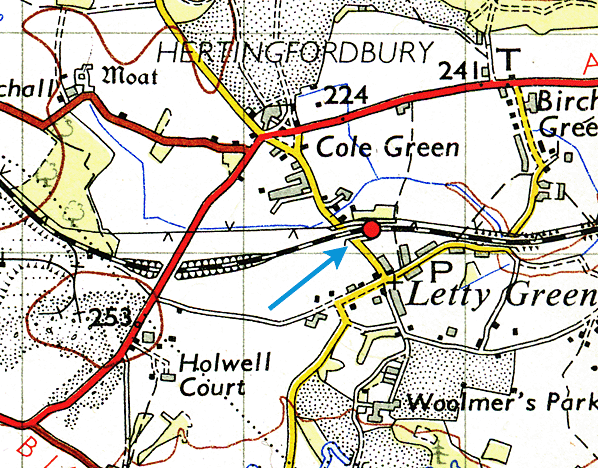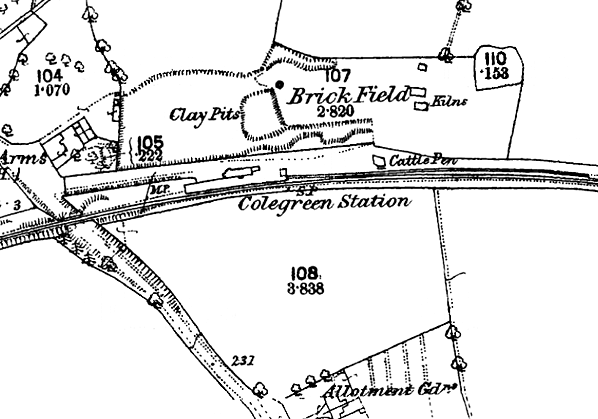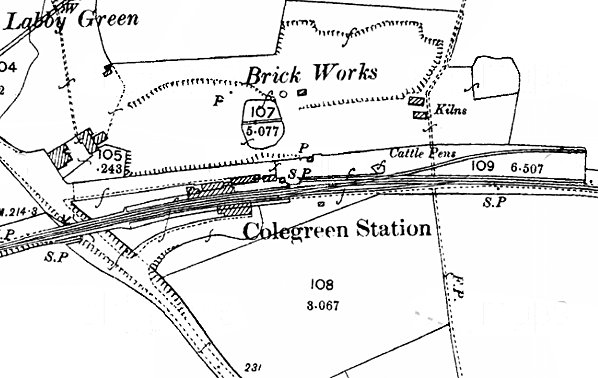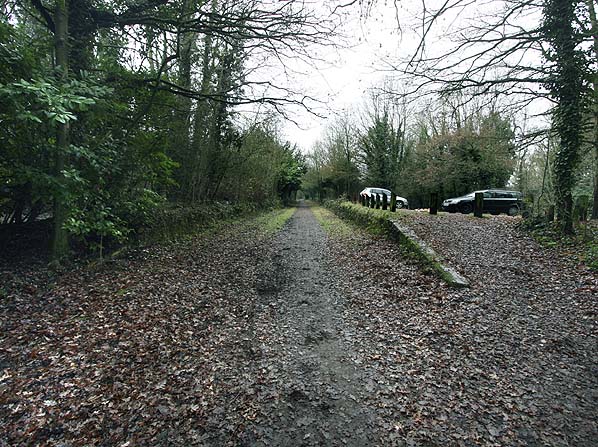
Station Name: COLE GREEN
|
| Date opened: | 1.3.1858 |
| Location: | On the east side of Station Road |
| Company on opening: | Hertford & Welwyn Junction Railway |
| Date closed to passengers: | 18.6.1951 |
| Date closed completely: | 1.8.1962 |
| Company on closing: | British Railways (Eastern Region) |
| Present state: | The station is a now picnic area and car park for the Cole Green Way. Both platforms are extant with some original fencing at the rear. The down platform is kept clear of undergrowth with the east end of the platform and station forecourt used as a car park. The up platform is heavily overgrown with some brickwork from the platform buildings remaining. The foundations of another small building can be found in the undergrowth to the east of the up platform. The goods yard is used as a picnic area with wooden seats and tables. The cattle dock is extant and parallel with the down line but set back from it by the width of a siding. |
| County: | Hertfordshire |
| OS Grid Ref: | TL285111 |
| Date of visit: | April 1975, April 1981 & 1st January 2011 |
Notes: The Hertford branch opened on 1st March 1858 but Cole Green station didn't appear in company timetables until December 1958; it served the villages of Cole Green and Letty Green. The station had a single platform on the down side of the line with a low, brick-edged platform. The two-storey station building incorporated the booking office and stationmaster's house. There was a modest goods yard to the east of the station comprising a loop and one siding, a cattle dock and cattle pens. The station was enlarged in 1891. A passing loop was provided together with a second platform. Both platforms were provided with timber waiting rooms which supported long wide canopies. The goods yard was also enlarged with an additional siding running diagonally across the yard and probably serving a coal yard. Access to the goods yard was controlled by a 30-lever signal box, unusually sited under the canopy at the west end of the down platform. The box opened on 1st July 1891 and closed on 1st September 1951 when it was downgraded to a ground frame. After closure to passengers on 18th June 1951 the station remained open for goods traffic but was downgraded to an unmanned public siding, finally closing on 1st August 1962. The loop line was lifted during the 1950s and all the timber buildings on the down platform were demolished, leaving just the brick stationmaster's house and booking office. The timber buildings and canopy of the up platform were demolished c.1963. After final closure of the line to all traffic in 1962 the remaining track was lifted c.1963. The remaining stationmaster's house stood empty for many years and gradually became more dilapidated; it was eventually demolished early in 1975. BRIEF HISTORY OF THE HERTFORD NORTH TO WELWYN GARDEN CITY LINE On 3rd July 1854, the Hertford & Welwyn Junction Railway received parliamentary authority to build a line from the Eastern Counties Railway at Hertford to a triangular junction with the GNR at Digswell with running powers into Digswell (which was later renamed Welwyn North). On 30th September 1854, there was a proposal to extend this line across the GNR to Luton and Dunstable linking three established railway companies (ECR, GNR & LNWR). Not wanting to be left out, the GNR offered to work the line between Hatfield and Luton although it was not prepared to provide any finance.
The Hertford line was opened to goods traffic on the last day of February 1888, with passenger services running from 1st March 1858 between Hertford (often referred to as Cowbridge) and Welwyn Junction on the GNR; the service was operated jointly by the GNR and the ECR. Welwyn Junction station provided interchange facilities with the Great Northern, and passengers could continue their journey south towards Kings Cross or north towards Peterborough. No intermediate stations were opened with the line, but by December 1858 stations at Cole Green and Hertingfordbury appeared in company timetables. The line continued east for a further 1200 yards beyond Hertford station to connect with the Eastern Counties terminus (later Hertford East) but this connection was never used by passenger trains. Work on the Luton line had been progressing during the amalgamation negotiations, and the first section of the line between Luton and Dunstable opened for passenger traffic on 3rd May 1858. Work at the Welwyn end of the line had started in April 1856, but little was done. The formation of the Hertford, Luton & Dunstable Railway was authorised by parliament on 28th June 1858 with new capital available to complete the line. On 28th January 1859 work was once again underway, and there was even a second 'cutting of the first sod' ceremony. On 19th April 1860 the H & LDR informed both the Eastern Counties Railway and the GNR that they were terminating the 1858 agreement. The GNR immediately took steps to take over the line because of its strategic importance as a link between the three main lines; a Parliamentary Bill was prepared to facilitate this. At this time the line was nearing completion, with a special train carrying LNWR officials on 12th June and another 'special' on 17th July for company shareholders. After passing its Board of Trade inspection, the line between Luton and the Great Northern was opened to both goods and passenger traffic on 1st September 1860.
Welwyn Junction station closed on the same day with trains on both lines making a junction with the Great Northern, and the services terminated at Hatfield where a bay platform was provided for Hertford trains.. The Hertford, Luton & Dunstable Railway was absorbed by the GNR under the Great Northern Railway Act of 12th June 1861. This gave the GNR exclusive rights to operate the line. In December 1868 new parallel lines into Hatfield were brought into use for both branch services, and the earlier junctions were removed in January 1869. In an attempt to attract more passengers to the Hertford line railmotors were introduced in 1905, and two new halts (Attimore Hall and Hatfield Hyde) between Welwyn junction and Cole Green first appeared in public timetables in May 1905, but they were not well used and closed a month later.
A new through station at Hertford North opened on 2nd June 1924 with the opening of the Hertford loop line, when the Enfield branch was extended north to create a diversionary route for the main line to King’s Cross. The new station was less well sited for the town centre than the earlier branch terminus at Cowbridge but it did provide Hertford with a service north to Stevenage for the first time. Cowbridge was now redundant and closed to passengers although it continued to handle goods traffic as there were no goods facilities at the new station.
Sentinel-Cammell steam railcars were tried on the line in 1930s and, although popular with passengers, could not cater for peak demand. From 17th September 1944 most trains from Hertford terminated at Welwyn Garden City rather than Hatfield. In common with many other branch lines, passenger numbers went into rapid decline after the war. In 1950 there were 5 down trains on weekdays with an extra train on Saturdays. There were 6 up trains on weekdays and 7 on Saturdays, and no Sunday service. It came as no surprise when closure was announced for 18th June 1951. The last train, the 7.18 pm service from Hertford North saw a number of passengers wearing Victorian costume to commemorate the passing of the line. The last two passenger service to use the line were railtours, an unadvertised Welwyn - Hertford branch railtour organised by the Stephenson Locomotive Society on 21st November 1959. Passengers arrived at Welwyn Garden City by service train from Kings Cross. They then transferred to a 2-car Cravens DMU for the journey to Hertford East via Cowbridge where they were booked to return to Liverpool Street via Broxbourne on a normal service. The second was the South Bedfordshire Locomotive Club's Lea Flyer on 16th September 1961 which ran from Welwyn Garden City to Hertford North, back to Welwyn Garden City, then on to Luton Bute Street.
After closure to passengers in 1951, the branch was used for the location of a number of films until the track was lifted in July 1967, with just a short section remaining to serve two factories, GKN Ltd and Norton Abrasives, near the site of Attimore Hall Halt. During the electrification of the East Coast Main Line the Hertford line was severed between Hatfield and Welwyn Garden City during the construction of a new flyover south of Welwyn Garden City. After this, the only access to the branch was from the Welwyn Garden City goods yard. Traffic to to GKN ceased in the mid 1970s although the siding officially remained open and by 1981 Norton Abrasives received one train per week with four to six wagons. The last working was on 12th November 1981 when a Class 31 collected empty wagons. Two weeks later two short pieces of rail were removed from the track at the point where the branch swung away from the main line and the remaining track was quickly lifted. The 6.5 mile Cole Green Way cycle and bridleway between Welwyn Garden City and Hertford now follows the course of the line. It is part of National Cycle Network Route 61, and the Lea Valley Walk. Sources: Hatfield, Luton & Dunstable Railway by G & S Woodward (1977). Published by Oakwood Press ISBN 978-0-853614-58-6. For further reading see Hertfordshire's lost railways by Keith Scholey ISBN ISBN 1 84033231 X and Branch Lined around Hertford & Hatfield by Vic Mitchell & Keith Smith (2009) Published by Middleton Press ISBN 978-1-906008-58-1 Click here to see an aerial view of the whole Welwyn Garden City - Hertford line line on Google Earth. All the stations are shown. Prepared by Mark Percival. Tickets from Michael Stewart route map drawn by Alan Young To see other stations on the Hertford North - Welwyn Garden City line click on the station name: Welwyn Garden City, Welwyn Junction, Attimore Hall Halt, Hatfield Hyde Halt, Hertingfordbury & Hertford North |
||||||||
green_old2.jpg)
Photo © National Railway Museum and SSPL



green_old10.jpg)
Photo received from Marjorie Cook(whose grandfather or great grandfather worked at the station
at this time)
green_old1.jpg)
Copyright photo from John Alsop collection
green_old8.jpg)
Photo from John Mann collection
green_old5.jpg)
Photo from John Mann collection
green_old3.jpg)
Photo from John Mann collection
green_old6.jpg)
Cole Green station looking east in 1963 after closure to all traffic.
Photo from John Mann collection
green10.jpg)
Photo by Ian Baker
green22.jpg)
Photo by J E Connor
green9.jpg)
Photo by Alan Young
green3.jpg)
Photo by Nick Catford
green5.jpg)

Photo by Photo by Nick Catford
Click here for more pictures of Cole Green station
| Last updated: Wednesday, 17-May-2017 09:16:24 CEST |
© 1998-2011 Disused Stations
|






 Home Page
Home Page